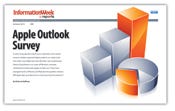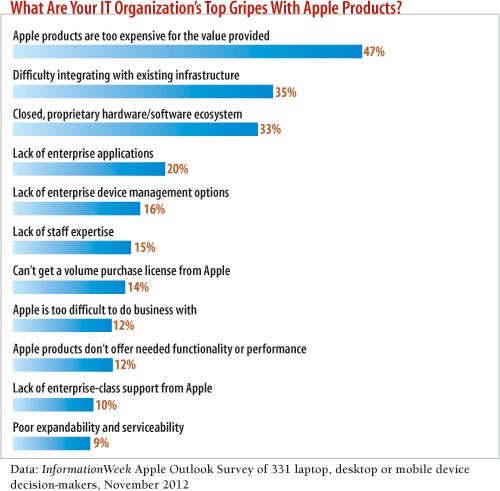Why Apple Is IT's Arch FrenemyWhy Apple Is IT's Arch Frenemy
Apple devices are supported in nine out of 10 companies, our research finds, but IT needs ways to manage them more efficiently and securely.

Our Apple Outlook Survey is decisive: More than 90% of the 331 IT decision-makers that we surveyed either already support iPhones and iPads or have plans to do so. Even more surprising is that more than 80% support or plan to support Mac laptops and desktops. The kind of sea change that represents can't be overstated -- not that long ago Apple's presence in the enterprise, outside of a few core markets, was negligible.
But is IT really on board or just bowing to pressure from users enamored of their iDevices? Judging by the mostly negative comments from the laptop, desktop and mobile device decision-makers who responded to the information survey, there's reason to believe IT would like nothing more than to go back to the days of top-down hardware purchasing.
"Apple products are nice, but they are not really suited to the enterprise because we have no means of ensuring their security," says one respondent. "Apple is slow to release security updates for known exploits. Their products are fine for home use and small business, but they have an outdated approach to security that is not really acceptable for Fortune 500 companies."
Until Apple can offer competitive management functionality, including complete integration with Active Directory, Group Policy and Exchange, "they will not be an IT enterprise 'go-to' solution," an IT director at a healthcare company says.
Research: Apple Outlook Survey
 Our full report on information's Apple Outlook Survey is free with registration.
Our full report on information's Apple Outlook Survey is free with registration.
Get This And All Our Reports
That attitude also shows up in the data center. When Apple abruptly killed its well-regarded Xserve rack-mount server line two years ago, IT pros saw it as one more bit of proof that Apple isn't a reliable enterprise partner. And not a whole lot has changed since.
Our survey underscores that IT still isn't enthusiastic about having Apple gear in the data center. No surprise that 64% of the IT decision-maker respondents have no Apple servers even though Apple still sells a server OS and server configurations for its Mac Pro and Mac Mini lines.
Apple appears to be "abandoning its long-term customers in an effort to jump with both feet into the mobile and tablet market, and we have had to re-evaluate our long-term plans for hardware and software accordingly," says a higher-education services coordinator. Apple's new software is "amateur" compared with previous offerings, he says, noting that Apple is changing its operating system to look and work like iOS. "It truly adds insult to injury after having gone 'against the current' championing them for so long," he says.

The End User End Run
Perhaps knowing that it has burned bridges with IT, Apple is putting more effort into marketing to business users.The results of our survey, which also included 243 end users, suggest that Macs and iDevices are making their way into the enterprise because users -- not IT managers -- like them. Nearly half of the IT organization respondents think Apple products are too expensive for the value they provide. They rated the cost of Apple gear midway between "poor" and "fair," and their value as only "fair."
End users rated Apple products between "good" and "excellent" on design, ease of use, reliability and innovation. When asked what's driving support for Apple products in their companies, respondents' top answer was "end user demand"; IT decision-makers gave that answer more than twice as frequently (65%) as the next most common answer, "ease of use" (32%).
It's no coincidence that Apple's interest in data center hardware waned just as the iPhone began to surpass the Mac in both unit sales and revenue. Apple's profit margins on its desktops and laptops are the envy of the industry, but sales and profits of its consumer-focused iOS devices now dwarf those of its desktops and laptops. Macintosh sales as a percentage of total revenue have fallen below 20%, and it's quite likely that figure will dip below 15% by the fourth quarter. Nevertheless, Mac sales continue to be solid, with Apple seeing a surprising number of record-setting quarters as competitors struggle with stagnant sales. Fourth-quarter U.S. unit sales of Apple desktops and laptops grew 5.4% last year compared with 4Q 2011, according to Gartner's preliminary estimate. Total U.S. PC sales fell 2.1% in that same quarter compared with the year-ago quarter, with some competitors seeing major declines. Dell's unit sales were down 16.5% for that quarter, and Acer's were down 21.6%.
Apple may not be a presence in the server room, but it's surging on the enterprise client side. Forrester predicts that Apple will sell $7 billion of Macs and $11 billion of iPads to companies this year and $8 billion and $13 billion, respectively, in 2014.
Apple's financial health is unparalleled, with profits rising year after year in magnitude, margin and often as a proportion of the markets where it competes. Apple's $41.9 billion profit over the last four quarters is more than twice the total of the combined profits of Acer, Asus, Dell, Hewlett-Packard, IBM, Intel and Lenovo.
Apple has used part of its huge cash stockpile to build a well-oiled machine to deliver top-quality products to consumers -- your executives and other end users -- and then support those products with an attention to detail and execution that's second to none. It's no wonder that users' perception of corporate IT teams, stretched thin and tasked with everything from provisioning to patching, may suffer in comparison to stopping in at Apple's Genius Bar.
Apple has made mistakes along the way, like its substandard iPhone Maps app and missteps that have led to complaints about some iPhone app developers improperly collecting users' Address Book information. But most of the data points to an extremely well-run operation.
So your fleet of iDevices is unlikely to lose vendor support. That's the good news. The bad news is that Apple has little financial incentive to meet enterprise needs, where costs and complexity tend to be higher and profits lower than in the premium consumer market it dominates.
Is iGear Worth The Cost?
Macs running OS X tend to be more stable than their PC counterparts, with fewer critical failures, OS corruptions and kernel panics (the Mac equivalent of the dreaded Windows BSOD). Some of this stability has to do with the unique advantage Apple has in delivering both the hardware and operating system for its products, which makes for a less chaotic environment in terms of components, drivers and compatibility. The number of variables is simply much smaller, as are the variations in quality and design typically found in the Windows PC world.
On the software side, Apple's Boot Camp multiboot utility and virtualization applications such as Parallels and VMware's Fusion let you run Windows on Macs, often at full speed and with excellent compatibility. Linux can similarly be run on the Mac. We've seen Apple hardware run Windows faster than some dedicated Windows machines.
In addition, Macs are still less likely to be infected with malware or to need the kind of time-consuming repair or OS reinstallations that Windows devices can require. It's arguable how much of this security is due to architectural and implementation decisions versus the Mac market share being a smaller target, and there has been more Mac-directed malware in recent years. But Macs are still, proportionally, much less likely to be infected with malware than Windows-based devices.
Nevertheless, Apple gear is expensive, and the company has refused to undercut its margins, maintaining that its products are worth the premium. The evidence bears out this perception: Apple's products score near the top of most reliability and customer satisfaction surveys.
Of course, when the business is paying, the calculation changes. Just 11% of IT decision-makers and end users in our survey rate the value of Apple products as excellent, and where we asked them to rate Apple tablets and smartphones across 12 criteria, they said they're least impressed with product cost and upgradability.
IT's Top Five Beefs
Apple is frequently criticized for putting design over function. "iMac connectors on the rear of [the] machine are designed/decided by anal retentive cretins," says one IT decision-maker in our survey. "This is an ergonomic flaw that reveals a preference for form over function." Ouch.
Another gripe: While, as our survey reflects, Apple is held up as a leading innovator, in reality it tends to refine existing ideas. Apple didn't invent the MP3 music player, the smartphone or the tablet computer. But it made the "breakthrough device" that took these products from niche to mass market, the Newton notwithstanding.
Success makes its own argument. And don't discount the possibility that more enterprise acceptance could lead Apple to actually start listening to CIOs and making choices that benefit enterprise IT. Apple didn't invent the USB port, but it adopted it as a universal interface, without including any legacy interfaces on the original iMac, at a time when relatively few PCs used USB -- helping jump-start widespread adoption.
Apple's record of "inflection point" success means, at the very least, it's worth closer attention from IT management. Whether we're talking about delivering digital music, tying an online store to a brick-and-mortar retail presence, developing a unibody laptop chassis, driving ubiquitous Wi-Fi or, of course, innovating smartphones and tablets, Apple has either been impossibly lucky or has managed to repeatedly anticipate and advance transformational technology trends.
Another beef IT has with Apple is with its inadequate enterprise support. Even the top-tier support level, AppleCare OS Support Alliance, is a business hours, next-business-day-response program for anything other than Priority 1 (system or service down) issues. Apple also has programs and a registry in place for training and certification, as well as AppleCare Professional Support and Apple Service Programs that provide businesses support, though again, not always with 24/7 availability, and they don't seem to be a major priority for the company.
Not surprisingly, only 32% of the IT decision-maker and 29% of the end user respondents to our survey say Apple is making an effort to improve enterprise support, and 39% of decision-makers and 27% of end-users say no such effort is under way.
Another potentially expensive pain point for organizations is Mac repairs and upgrades. Apple would do more business with IT organizations if it made schematics and repair information more accessible, says Christopher Grande, president of OnSight Services, an IT consultancy. "They should change to standard screws and closures to make repairing an out-of-warranty item possible for the power user types," Grande says. "It would add great value and show that they care how long their products remain in the marketplace. When I see a 20-year-old Volvo or a 10-year-old Dell, that's a tremendous selling point."
Screws aside, not all Macs have inaccessible designs. The latest Mac Pro, for instance, has a fantastic case design that makes upgrading components a breeze. The Mac Mini lets customers upgrade to 16 GB (8 GB times two slots) of RAM and add a second hard drive or SSD.
But for the most part, Apple appears to be extending the sealed-unit approach it takes with its phones and tablets to its new Macs, putting a premium on cutting-edge design over upgradability. The ultrathin cross section of the latest iMac desktop is a case in point. In the most recent refresh of the line (late 2012), even the RAM in the smaller of the two units (the 21.5-inch version) is almost inaccessible. The larger (27-inch) model still has easily accessible RAM.
Apple's recent laptops -- the MacBook Air and the newest MacBook Pros -- have a sealed-unit design. Apple now solders the RAM to the motherboard and has made key components such as the hard drive or SSD, battery and screen much less accessible.
Repair site iFixit gave the new 15-inch Retina MacBook Pro its lowest possible rating, one out of 10 points, for upgradability and access based on factors such as nonstandard pentalobe screws, soldered-in RAM, proprietary flash memory SSD, glued-in battery modules and a fused display assembly. At least one third-party vendor has released MacBook Pro-compatible SSD modules for the Retina MacBook Pro, so there's the possibility of boosting internal storage. But in general, post-purchase upgrades for new Apple devices are limited.
If your desktops and laptops are on a two- to three-year replacement life cycle, Apple's approach might be a non-issue, but if you replace your hardware less frequently, consider either maxing out the devices at the time of purchase or choosing another option.
And that brings us to what might just infuriate IT pros the most: While Apple clearly is an influential innovator, it's a relatively inflexible one, which makes dealing with the company and its products, frankly, risky.
Apple has thrived on creating disruptive products and services -- to paraphrase a famous ad campaign, by thinking (and acting) differently. What that really means is that it's fond of changing the rules and upsetting the board rather than playing within established markets and systems. One example is Apple's arm-twisting of AT&T and other telecom carriers to change their business models to accommodate the iPhone. Another example is the heavily curated walled-garden App Store model for iOS apps.
Apple thrives when it can step in as the first mover, or at least the first successful mover, and deliver premium products perceived as different and better. It hasn't done well long term in markets for commoditized products and during periods when it hasn't been able to make its distinctive characteristics clear.
In short, Apple courts relentless change, not the slow, incremental change more in tune with a corporate environment.
CIOs place a premium on consistency and reliability. High availability and stability are much more important in corporate tech environments than new features or even usability.
Enterprise IT is about managing chaos and eliminating surprise -- reliability over delighting end users. This is not to say Apple products aren't reliable; they are. It's a more fundamental difference. Whereas Apple is intensely focused on the individual user experience, enterprise IT, by nature, is focused at the aggregate, collective level.
What's Next?
Based on our survey results, IT has little choice but to gamely move ahead with Apple products. While only 11% of IT decision-maker respondents say their companies spend more than 20% of their IT budgets on Apple products and only 23% spend more than 10%, that number may creep up. Asked to look ahead 18 months, 16% predict that their companies will spend more than 20% of their IT budgets on Apple gear, and 31% estimate they will spend more than 10%. The possibility that nearly one-third of companies would even consider spending more than 10% of their IT budgets on Apple products would have been considered ludicrous even a few years ago.
CIOs must be deliberate and realistic about when and how they support Macs and iOS devices. Apple, for its part, can take advantage of its momentum in the consumer market to build strong ties with IT pros by investing in enterprise-class functionality and services. If it doesn't, there may well be a "reverse halo effect," where management difficulties with and operational failures of its products in the workplace tarnish the brand. Does Apple care? We'll see.
Continue to the sidebars:
Apple Doesn’t Rule The School,
Close The BYOD Security Hole
About the Author
You May Also Like






